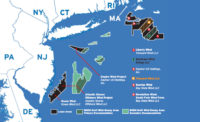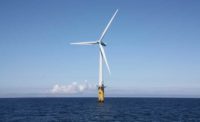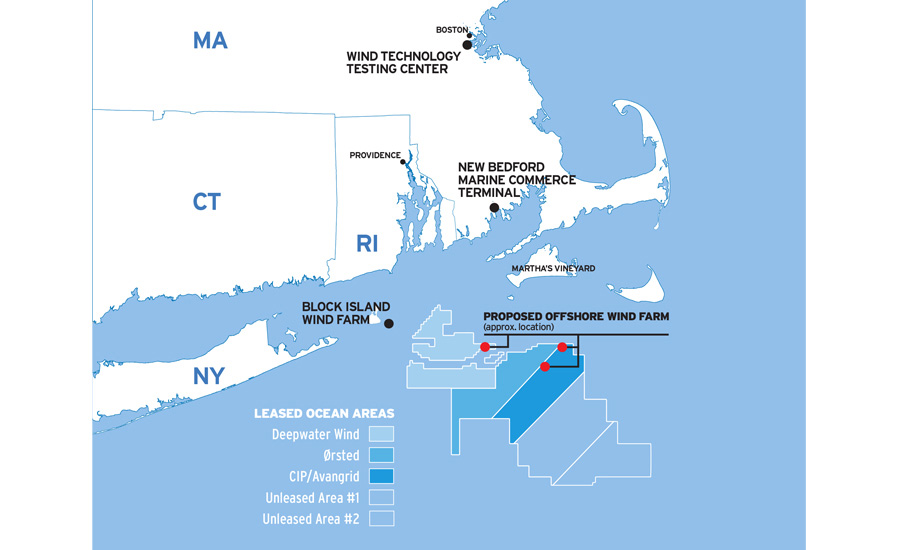New England Bets Big on Offshore Wind Power

A New Bedford, Mass., port terminal is set for upgrade and expansion to support planned offshore wind projects in Massachusetts and Rhode Island and industry growth.
Photo: Massachusetts Clean Energy Center

Wind farms planned off Rhode Island and Massachusetts in federal leased areas are set to generate 1,200 MW of energy.
ENR Map by Dylan Schutter

New England now has bet big on offshore wind power, with two states moving on May 23 to site three turbine complexes that will generate a total of some 1,200 MW of power, and investing heavily in onshore facilities to build an Atlantic coast construction hub and supply chain.
Massachusetts chose developer Vineyard Wind to build 800 MW—half of the state's intended 10-year offshore wind energy goal—and Rhode Island picked Deepwater Wind to build 400 MW.
The latter developed the first and only operating U.S. offshore wind facility at Block Island, generating 30 MW.
The hugely scaled-up new projects, to be located south of Martha’s Vineyard in leased federal ocean sites, represent what Massachusetts Gov. Charlie Baker (R) called the “largest single offshore wind procurement in the world.”
Related Link
U.S. Offshore Wind Power is Blowing on West Coast
Supply Chain
In the deal, Vineyard will invest $10 million to boost supply chain growth with upgraded or new facilities and infrastructure, while Deepwater is spending $40 million to develop Rhode Island ports.
“The Northeast has been called the Saudi Arabia of offshore wind for its consistency,” says Steve Pike, CEO of the Massachusetts Clean Energy Center. It assessed 18 potential manufacturing investment sites and is holding forums to link top-tier suppliers with local business. He says the upgraded New Bedford, Mass., marine terminal is ready for offshore wind construction support, with the Vineyard project to be based there.
The state expects to issue another wind farm solicitation in about one year to create a project pipeline. “We’re optimistic,” says Pike.
Roy Francis, senior vice president of Louisiana-based Gulf Coast Fabricators, which built and installed steel foundations for the Block Island farm, says the firm is weighing a northeast fabrication yard to support U.S. offshore wind growth.
“Hopefully, the majority of steel fabrication will be done in the U.S.,” he says, but notes that steel parts can also be imported from China and Europe.
Vineyard also is investing about $2 million to build a skilled offshore wind workforce centered in southeast Massachusetts for an estimated 3,600 new jobs, including 1,500 in construction. Deepwater Wind’s project is expected to create more than 800 construction jobs. It plans to invest $250 million locally and says it has not received tax incentives or credits.
Massachusetts selected Vineyard’s estimated $2-billion proposal for power and associated undersea transmission lines that would have 400 MW on line in 2021 and 400 MW in 2022. It is a joint venture of U.S.-based Avangrid Renewables, part of Spain’s Iberdrola Group, and Copenhagen Infrastructure Partners, a Danish investment fund.
Three major Massachusetts' utilities—National Grid, Eversource Energy and UNITIL—delayed the selection by a month, citing the unexpected complexity of the three bids submitted and other factors. The three bids, were actually 20 separate submissions—some with multiple pricing and other options that included several complex scenarios that required detailed and demanding analysis.
A contract with Vineyard must be negotiated by July 2 and submitted by July 31 to state regulators. Vineyard filed in December the required federal environmental and construction operations plans to begin work in 2019 and is negotiating to secure transmission services and power purchase agreements.
In its proposal, Vineyard said the project would provide $3.72 billion of benefits to Massachusetts.
"While the federal administration sits out this race, Massachusetts has the chance to win it with historic offshore wind projects," said Meagan Greene, Senior Director of Policy and Operations at The Alliance for Business Leadership in Boston, in a June 6 opinion in The Lowell (Mass.) Sun. "In addition to the economic benefits, a project of this size will contribute to Massachusetts' emission reduction targets set in the Global Warming Solutions Act in 2008."
Pace Quickens
Rhode Island picked Deepwater Wind’s project through participation in Massachusetts’ clean energy procurement process. State regulators independently evaluated proposals, said Gov. Gina Raimondo (D). Last year she set a goal to have 1,000 MW of clean energy by 2020.
Deepwater Wind is negotiating with utility National Grid. Survey work has begun, and construction could begin in 2020, with the project on line in 2023. The 50-turbine project will be in the same federal lease area as Deepwater’s 90-MW South Fork wind farm that was approved last year by New York’s Long Island Power Authority.
The projects’ fast schedule is based on recently-built projects in Europe and will include the latest-generation turbine generators on a monopole foundation.
Cables from each turbine will connect to an electrical service platform where power is transformed from 66 kV to 220 kV. The cable to the transformer onshore will be buried six feet under the sea floor.
The two 400-MW projects will deliver power without needing to upgrade the existing transmission system, says Vineyard.
Deepwater Wind proposed adding offshore wind incrementally to take advantage of falling costs and coupling it with grid-scale pumped-storage and expandable transmission. The firm did not disclose the capacity amount it proposes to build initially. Adding wind incrementally could save ratepayers from $300 million to $600 million, the company said. The proposal for the Revolution Wind project is designed to serve as a regional energy center, according to Deepwater Wind.
Bay State Wind, a joint venture of developers Orsted and Eversource and the only bidder not selected, “remains fully committed” to the partnership, it says. The pair has since submitted a 200-MW offshore wind bid in Connecticut.
New Jersey aims to kickstart a goal to develop 3,500 MW by 2030 with a bill signed by Gov. Phil Murphy (D) on May 31 that requires regulators to review within 90 days the long-planned 24-MW Fishermen’s Energy project that predecessor Gov. Chris Christie (R) opposed.
New York plans to have 2,400 MW come on line by 2030






